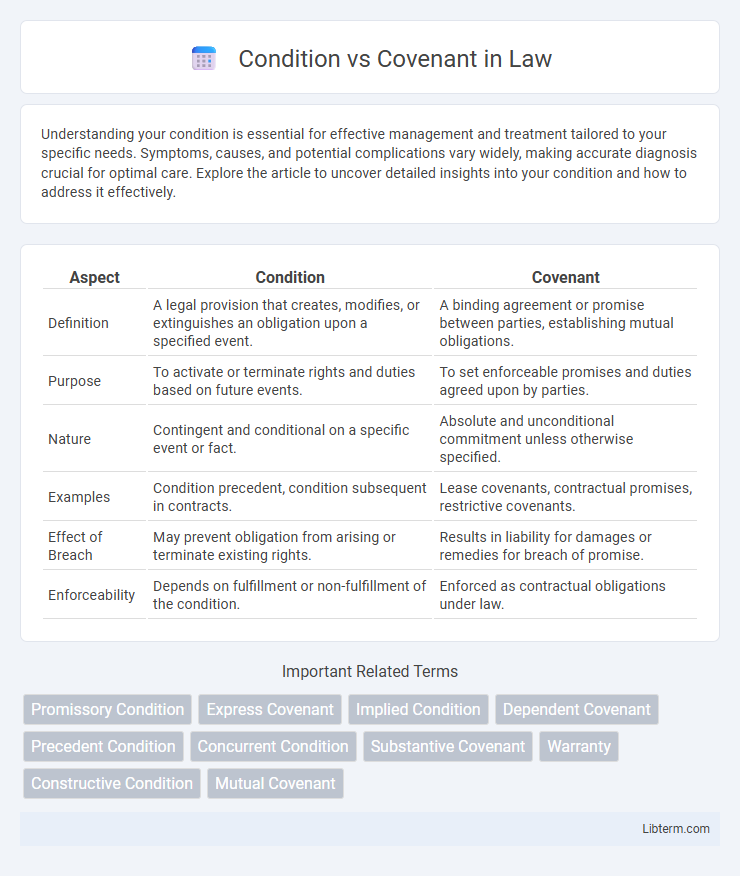Understanding your condition is essential for effective management and treatment tailored to your specific needs. Symptoms, causes, and potential complications vary widely, making accurate diagnosis crucial for optimal care. Explore the article to uncover detailed insights into your condition and how to address it effectively.
Table of Comparison
| Aspect | Condition | Covenant |
|---|---|---|
| Definition | A legal provision that creates, modifies, or extinguishes an obligation upon a specified event. | A binding agreement or promise between parties, establishing mutual obligations. |
| Purpose | To activate or terminate rights and duties based on future events. | To set enforceable promises and duties agreed upon by parties. |
| Nature | Contingent and conditional on a specific event or fact. | Absolute and unconditional commitment unless otherwise specified. |
| Examples | Condition precedent, condition subsequent in contracts. | Lease covenants, contractual promises, restrictive covenants. |
| Effect of Breach | May prevent obligation from arising or terminate existing rights. | Results in liability for damages or remedies for breach of promise. |
| Enforceability | Depends on fulfillment or non-fulfillment of the condition. | Enforced as contractual obligations under law. |
Understanding Conditions and Covenants
Conditions and covenants are essential components in contracts and agreements, defining obligations and triggers for specific actions. A condition specifies a prerequisite event or circumstance that must occur for the contract to become effective or for an obligation to be enforced, often serving as a contingency or qualification. Covenants are promises or commitments by one party to perform or refrain from certain actions, establishing ongoing duties regardless of external events once the contract is active.
Defining Conditions in Legal Agreements
Defining conditions in legal agreements establishes specific criteria or events that must be met or occur for contractual obligations to be enforceable, differentiating from covenants which are promises to perform certain actions. Conditions precedent require fulfillment before a party's duty arises, while conditions subsequent terminate obligations upon an event. Precise articulation of such conditions ensures clarity in rights and responsibilities, reducing ambiguities in contract enforcement.
What is a Covenant? Key Differences
A covenant is a formal, legally binding agreement or promise between two or more parties that outlines specific obligations or guarantees, often found in contracts, real estate, and religious contexts. Unlike a condition, which is a stipulation that must be met for a contract to be valid or a right to be exercised, a covenant represents a commitment to act or refrain from acting, independent of other conditions. Key differences include the nature of enforcement: conditions trigger or terminate obligations based on occurrence, while covenants require ongoing compliance with agreed terms regardless of other factors.
Conditions vs Covenants: Core Distinctions
Conditions are specific requirements that must be met for contractual obligations to become enforceable, often affecting the validity or timing of performance. Covenants represent promises or commitments within a contract that require ongoing or future action, independent of conditions precedent. The core distinction lies in conditions acting as triggers for obligations, whereas covenants are continuous duties that support the contract's overall purpose.
Legal Implications of Conditions
Conditions in contracts impose specific legal requirements that must be met for contractual obligations to become enforceable, affecting the rights and duties of parties involved. Failure to fulfill a condition can lead to contract termination, non-performance liability, or specific remedies such as damages or restitution. Courts often analyze the language and intent of conditions to determine their legal effect, distinguishing them from covenants that represent promises rather than prerequisites.
Enforceability of Covenants
Enforceability of covenants hinges on their specificity, reasonableness, and adherence to statutory requirements, distinguishing them from conditions which are often absolute stipulations. Courts typically evaluate covenants based on factors like duration, geographic scope, and consideration to prevent undue hardship or restraint of trade. Unlike conditions that void contracts if unmet, valid covenants impose ongoing obligations or restrictions enforceable through injunctive relief or damages.
Practical Examples: Condition vs Covenant
A condition in a contract requires specific actions or events to occur before obligations activate, such as a buyer's obligation to pay only after the seller delivers goods. A covenant represents a promise to perform or refrain from certain acts regardless of external events, like a tenant agreeing to maintain the property throughout the lease term. Practical examples highlight that failure to satisfy a condition can void the contract, while breaching a covenant typically results in damages or specific performance remedies.
Drafting Effective Conditions and Covenants
Drafting effective conditions and covenants requires precise language that clearly defines obligations and triggers to avoid ambiguities in enforcement. Conditions must specify exact performance or occurrence requirements, limiting subjective interpretation, while covenants should establish measurable and consistent duties that align with contractual intent. Incorporating specific timelines, remedies for breach, and clear consequences enhances legal certainty and facilitates dispute resolution.
Common Pitfalls in Using Conditions and Covenants
Common pitfalls in using conditions and covenants include unclear or ambiguous language that can lead to misinterpretation and legal disputes. Many agreements fail to specify exact triggers or thresholds for conditions, causing enforcement challenges and unintended breaches. Overlooking the differentiation between conditions precedent and subsequent may result in premature obligations or termination risks, undermining contract effectiveness.
Best Practices for Choosing Between Condition and Covenant
When choosing between a condition and a covenant, prioritize clarity of obligations and consequences to ensure enforceability and minimize disputes. Conditions typically hinge on the occurrence of a specific event, while covenants involve ongoing promises or prohibitions, making contract intent and context key factors in selection. Legal practitioners recommend drafting conditions for event-based triggers and covenants for continuous duties to align contract performance with parties' expectations and risk management objectives.
Condition Infographic

 libterm.com
libterm.com